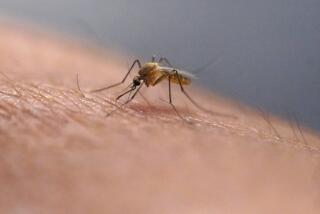Quick Tests for West Nile Aid in Battle
- Share via
As part of a statewide effort to combat the spread of the potentially deadly West Nile virus, San Bernardino County is one of nearly 20 in California using new viral testing methods that provide almost instant results, authorities said Tuesday.
During last year’s outbreak, many local health officials relied on a state laboratory in Davis for testing, a process that could take weeks.
Vector control districts “need a quick turnaround time” to respond to the virus, said Min-Lee Cheng, district manager of the West Valley Mosquito and Vector Control District, which includes Ontario, Chino and Rancho Cucamonga. “I can’t afford to wait for 12 to 14 days to get results.”
This year the virus has been detected in one sentinel chicken in San Bernardino County, three dead birds in Los Angeles County and nine dead birds in Orange County, plus a batch of mosquitoes there.
This year, no humans in California have yet contracted West Nile virus -- which is spread through mosquitoes that have fed on infected birds -- according to state records. One Los Angeles County resident, now recovering, was infected last year, but had been mistakenly counted this year as having contracted the disease.
In 2004, the virus infected a reported 830 people statewide, killing 28.
About one-third of California counties will use two types of rapid-result test kits this year, after their limited trial by the Department of Health Services in 2004, officials said.
San Bernardino County will spend $50,000 on about 4,000 test kits as part of $130,000 allocated to combat West Nile, local health officials said Tuesday. These will supplement about 500 kits used by the West Valley Mosquito and Vector Control District.
Each test evaluates either material swabbed from a dead infected bird’s mouth or ground-up trapped mosquitoes. It looks for indicators of the virus and delivers results in a lab in either 15 or 90 minutes and are from 65% to 80% accurate.
The flexibility of immediate results will help direct resources most efficiently, said Vicki Kramer, chief of the vector-borne disease section of the California Department of Health Services.
“We can step up our control efforts in order to prevent West Nile virus from spreading,” said Stephanie Heintz, public information officer for the Greater Los Angeles County Vector Control District in Santa Fe Springs.
Public health officials predict that Central and Northern California, plus Oregon and Washington, will be hardest hit by West Nile this year. Counties are reporting infected animals weeks earlier than in 2004, which is partially attributable to already-infected mosquitoes leaving hibernation. Record-breaking rains could also provide breeding grounds for the insects, Kramer said.
County health officials flew over the western part of San Bernardino County last week to inspect backyards for standing water, where mosquitoes can breed, and found that one-fifth of the pools they saw contained green, stagnant water. Securing window screens, dumping standing water and wearing insect repellent or long pants can help reduce exposure to infected mosquitoes.
Elderly people are the most likely to be affected by a West Nile infection, but 80% of infected people have none of the flu-like symptoms of headache, nausea or fever usually associated with the disease.
Upland resident Jack Raney, 47, contracted West Nile last August and was in a coma for four days and hospitalized for six weeks. After neurological damage from the virus, he needed physical therapy to learn to walk again.
He struggles with anxiety and can no longer work as a brick mason.
“It’s a life-altering experience,” Raney said.
“He’s not the same man that he was before,” said Raney’s wife, Cheri, 38.
More to Read
Sign up for Essential California
The most important California stories and recommendations in your inbox every morning.
You may occasionally receive promotional content from the Los Angeles Times.










